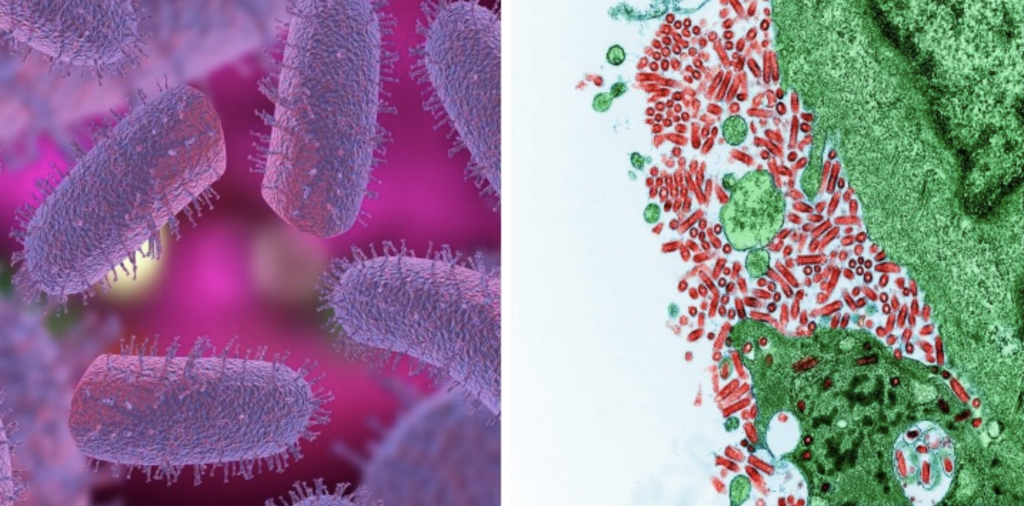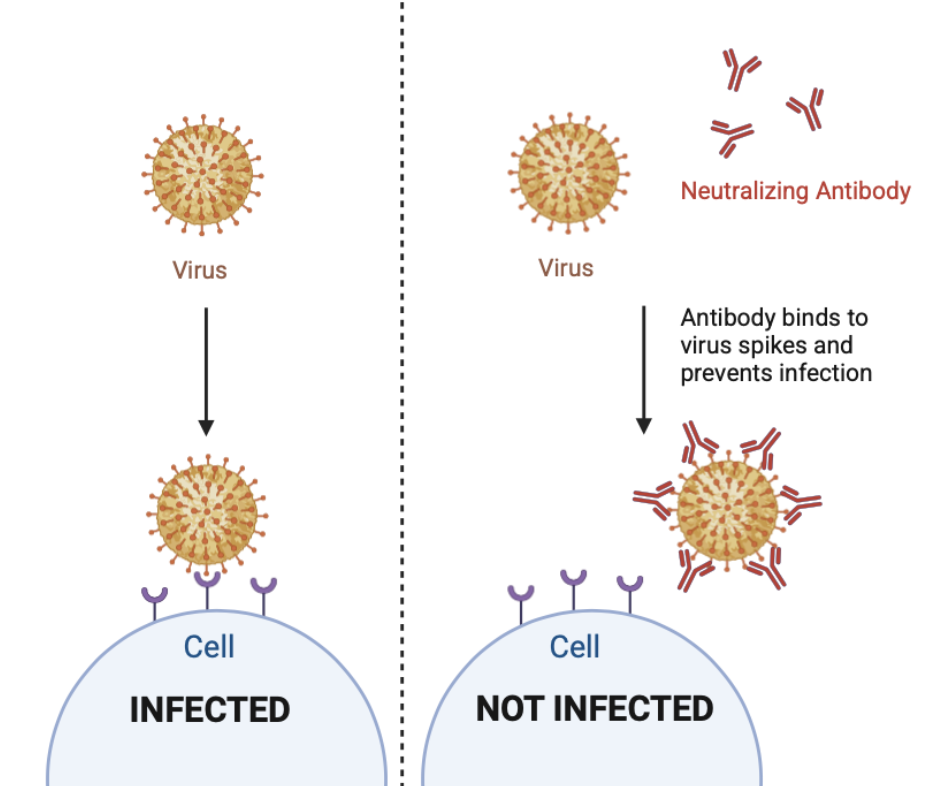by Jenna Grabowski
Whether you grew up with a pet or were told as a kid to stay away from wild animals, you’ve most likely heard of rabies. When people say “rabies,” they are usually referring to the disease caused by the rabies virus. Rabies virus is a rod-shaped virus that is spread through saliva or mucus (Figure 1). Rabies is usually transmitted through the saliva of an infected animal coming into contact with a person’s broken skin, typically via a bite or scratch. The virus is then able to infect cells and travel into a person’s nervous system. It typically takes the virus anywhere from 10-50 days to reach a person’s nervous system. Luckily, this time frame allows for treatment intervention before the disease becomes fatal.

Figure 1. (Left) Rabies virus is a small, rod-shaped virus. (Right) This is a microscopic image of the rabies virus (red) infecting cells in a culture (green). Color has been added to assist in visualization.
Rabies is commonly associated with a number of unique symptoms including aggression, hallucinations, and hydrophobia (the fear of water). This is because the virus is neurotropic, which means the virus infects your nervous system which includes the brain. Once inside the brain cells, or neurons, the virus replicates and causes damage. This damage results in inflammation of the brain as the immune system tries to get rid of the virus. Specifically, the rabies virus causes damage in the area of the brain that controls functions like swallowing, speaking, and breathing. The damage caused in this area of the brain results in spasms of the throat muscles. Due to these spasms, those infected with rabies typically have a hard time swallowing which results in excess saliva produced in the mouth as well as the fear of swallowing water. The build-up of saliva can cause the appearance of foaming at the mouth. Depictions of rabies typically include this aspect of the disease as animals or people infected with rabies commonly have saliva or foam around their mouths (Figure 2).

Figure 2. Animals with rabies can appear aggressive, have jerky movements, and show foaming at the mouth. Image source.
Rabies is considered one of the deadliest viral infections. Once the virus reaches the brain and symptoms appear, it is almost impossible to treat and is nearly 100% fatal. But fear not! There are multiple steps that are taken to avoid transmission of rabies to people. One important strategy is ensuring all domestic dogs (pets) are vaccinated against rabies to prevent transmission from wild animals to pets. There are also human vaccines available for both pre- and post-exposure to rabies. The first vaccination known as Pre-exposure prophylaxis or PrEP is for people who are in high-risk jobs (such as those who work in labs handling rabies or other related viruses) and people whose professional/personal activities might lead to them coming into contact with infected animals more than the average person. The second type of vaccine is known as Post-exposure prophylaxis or PEP. PEP is the emergency response to rabies that is used after a person comes into contact with an animal suspected to be infected by rabies. The goal of administering this treatment is to prevent the virus from reaching the nervous system. For this reason, it is important that it is given as soon as possible after contact with an animal possibly infected with rabies. PEP includes two main treatments: the first is a shot that contains pre-made antibodies against the virus. These antibodies act as neutralizing antibodies which are able to very quickly bind to the virus to prevent it from infecting a cell (Figure 3). This is given because the premade antibody can act fast and prevent the symptoms of rabies. The second shot given is a vaccination against the rabies virus. This shot is different from the first, as rather than containing premade antibodies, the shot contains dead virus. This form of the virus is unable to cause rabies, and instead allows the body to learn how to identify the virus and make its own antibodies from scratch. Antibodies made from scratch in your body can last longer and offer more protection if you ever come into contact with the rabies virus again.

Figure 3. Neutralizing antibodies are given to people who may have been exposed to the rabies virus. The antibody binds to the virus and prevents the virus from infecting a cell. If the virus cannot infect a cell, it cannot replicate and cause damage. Image created by author using BioRender.
While the idea of rabies can be scary, it is also intriguing and demonstrates the abilities of viruses to cause disease. It is also a testament to humankind, and our ability to create modern therapeutics against even the deadliest of pathogens. While it may seem that viruses are always one step ahead, we are never far behind.
